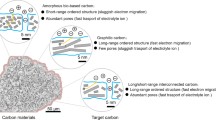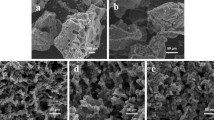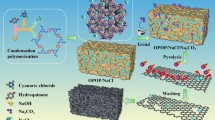Abstract
Meso-/macropore structure and graphite microcrystallite are two critical impacts on high-rate supercapacitive energy storage performance of nanoporous carbon. In the present paper, we prepared a novel graphitic carbon with three-dimensional interconnected meso-/macroporous nanonetwork by a simple one-step Friedel–Crafts crosslinking reaction. A metal-containing aromatic molecule, ferrocene, is selected as started building units. The crosslinking reaction of aromatic rings leads to the formation of meso-/macroporous nanonetworks, and the Fe element can act as a catalyst to accelerate the formation of graphite microcrystallite during carbonization. The experimental results show that the crystal sizes along the c-axis direction (L c) of the as-obtained graphitic porous carbons are 0.92–1.49 nm and the graphitization do not damage nanopore structure, so that their surface areas are higher than 500 m2 g−1. Owing to their unique structural features, i.e., meso-/macroporous network can shorten the ion transport distance and accelerate ion transport rate, and the moderate graphite microcrystalline is beneficial for electron transfer, this graphitic porous carbon shows high-rate supercapacitive energy storage. For example, the capacitance retention of the as-prepared samples can reach 88 % when the scan rate was raised from 10 to 300 mV s−1.







Similar content being viewed by others
References
Acerce M, Voiry D, Chhowalla M (2015) Metallic 1T phase MoS2 nanosheets as supercapacitor electrode materials. Nat Nanotechnol 10:313–318
Fang Y, Luo B, Jia Y et al (2012) Renewing functionalized graphene as electrodes for high-performance supercapacitors. Adv Mater 24:6348–6355
Su DS, Schlogl R (2010) Nanostructured carbon and carbon nanocomposites for electrochemical energy storage applications. ChemSusChem 3:136–168
Tao Y, Xie X, Lv W et al (2013) Towards ultrahigh volumetric capacitance: graphene derived highly dense but porous carbons for supercapacitors. Sci Rep 3:2975
Liu GJ, Fan LQ, Yu FD et al (2013) Facile one-step hydrothermal synthesis of reduced graphene oxide/Co3O4 composites for supercapacitors. J Mater Sci 48:8463–8470. doi:10.1007/s10853-013-7663-4
Chang L, Wei W, Sun K, Hu Y (2015) 3D flower-structured graphene from CO2 for supercapacitors with ultrahigh areal capacitance at high current density. J Mater Chem A 3:10183–10187
Huang Y, Huang Y, Zhu M et al (2015) Magnetic-assisted, self-healable, yarn-based supercapacitor. ACS Nano 9:6242–6251
Kou Y, Xu Y, Guo Z, Jiang DL (2011) Supercapacitive energy storage and electric power supply using an aza-fused π-conjugated microporous framework. Angew Chem Int Ed 50:8753–8757
Meng W, Chen W, Zhao L et al (2014) Porous Fe3O4/carbon composite electrode material prepared from metal-organic framework template and effect of temperature on its capacitance. Nano Energy 8:133–140
Chen AB, Yu YF, Xing TT, Wang RJ, Zhang Y, Li Q (2015) Synthesis of graphitic carbon spheres for enhanced supercapacitor performance. J Mater Sci 50:5578–5582. doi:10.1007/s10853-015-9106-x
Li Z, Xu Z, Wang H et al (2014) Colossal pseudocapacitance in a high functionality–high surface area carbon anode doubles the energy of an asymmetric supercapacitor. Energy Environ Sci 7:1708–1718
Wu D, Li Z, Zhong M, Kowalewski T, Matyjaszewski K (2014) Templated synthesis of nitrogen-enriched nanoporous carbon materials from porogenic organic precursors prepared by ATRP. Angew Chem Int Ed 53:3957–3960
He X, Ling P, Qiu J et al (2013) Efficient preparation of biomass-based mesoporous carbons for supercapacitors with both high energy density and high power density. J Power Sources 240:109–113
Nishihara H, Kyotani T (2012) Templated nanocarbons for energy storage. Adv Mater 24:4473–4498
Chaikittisilp W, Ariga K, Yamauchi Y (2013) A new family of carbon materials: synthesis of MOF-derived nanoporous carbons and their promising applications. J Mater Chem A 1:14–19
Zhong M, Kim EK, McGann JP et al (2012) Electrochemically active nitrogen-enriched nanocarbons with well-defined morphology synthesized by pyrolysis of self-assembled block copolymer. J Am Chem Soc 134:14846–14857
Ling Z, Yu C, Fan X et al (2015) Freeze-drying for sustainable synthesis of nitrogen doped porous carbon cryogel with enhanced supercapacitor and lithium ion storage performance. Nanotechnology 26:374003
Wang DW, Li F, Liu M, Lu GQ, Cheng HM (2008) 3D aperiodic hierarchical porous graphitic carbon material for high-rate electrochemical capacitive energy storage. Angew Chem Int Ed 47:373–376
Xu F, Cai R, Zeng Q et al (2011) Fast ion transport and high capacitance of polystyrene-based hierarchical porous carbon electrode material for supercapacitors. J Mater Chem 21:1970–1976
Li Q, Jiang R, Dou Y et al (2011) Synthesis of mesoporous carbon spheres with a hierarchical pore structure for the electrochemical double-layer capacitor. Carbon 49:1248–1257
Liang Y, Liang F, Wu D, Li Z, Xu F, Fu R (2011) Construction of a hierarchical architecture in a wormhole-like mesostructure for enhanced mass transport. Phys Chem Chem Phys 13:8852–8856
Liang QH, Ye L, Huang ZH et al (2014) A honeycomb-like porous carbon derived from pomelo peel for use in high-performance supercapacitors. Nanoscale 6:13831–13837
Portet C, Yushin G, Gogotsi Y (2007) Electrochemical performance of carbon onions, nanodiamonds, carbon black and multiwalled nanotubes in electrical double layer capacitors. Carbon 45:2511–2518
Pandolfo AG, Hollenkamp AF (2006) Carbon properties and their role in supercapacitors. J Power Sources 157:11–27
Ding J, Wang HL, Li Z et al (2013) Carbon nanosheet frameworks derived from peat moss as high performance sodium ion battery anodes. ACS Nano 7:11004–11015
Fu RW, Li ZH, Liang YR, Li F, Xu F, Wu DC (2011) Hierarchical porous carbons design, preparation, and performance in energy storage. New Carbon Mater 26:171–179
Chai GS, Shin IS, Yu JS (2004) Synthesis of ordered, uniform, macroporous carbons with mesoporous walls templated by aggregates of polystyrene spheres and silica particles for use as catalyst supports in direct methanol fuel cells. Adv Mater 16:2057–2061
Fang B, Kim M-S, Kim JH, Lim S, Yu J-S (2010) Ordered multimodal porous carbon with hierarchical nanostructure for high Li storage capacity and good cycling performance. J Mater Chem 20:10253–10259
Li S, Liang Y, Wu D, Fu R (2010) Fabrication of bimodal mesoporous carbons from petroleum pitch by a one-step nanocasting method. Carbon 48:839–843
Deng YH, Liu C, Yu T et al (2007) Facile synthesis of hierarchically porous carbons from dual colloidal crystal/block copolymer template approach. Chem Mater 19:3271–3277
Zou C, Wu D, Li M et al (2010) Template-free fabrication of hierarchical porous carbon by constructing carbonyl crosslinking bridges between polystyrene chains. J Mater Chem 20:731–735
Wu D, Hui CM, Dong H et al (2011) Nanoporous polystyrene and carbon materials with core-shell nanosphere-interconnected network structure. Macromolecules 44:5846–5849
Li ZH, Wu DC, Huang X et al (2014) Fabrication of novel polymeric and carbonaceous nanoscale networks by the union of self-assembly and hypercrosslinking. Energy Environ Sci 7:3006–3012
Zhai DY, Du HD, Li BH, Zhu YA, Kang FY (2011) Porous graphitic carbons prepared by combining chemical activation with catalytic graphitization. Carbon 49:725–729
Wang YG, Zhang CL, Kang SF et al (2011) Simple synthesis of graphitic ordered mesoporous carbon supports using natural seed fat. J Mater Chem 21:14420–14423
Wu D, Xu F, Sun B, Fu R, He H, Matyjaszewski K (2012) Design and preparation of porous polymers. Chem Rev 112:3959–4015
Wu DC, Nese A, Pietrasik J et al (2012) Preparation of polymeric nanoscale networks from cylindrical molecular bottlebrushes. ACS Nano 6:6208–6214
Zeng Q, Wu D, Zou C et al (2010) Template-free fabrication of hierarchical porous carbon based on intra-/inter-sphere crosslinking of monodisperse styrene-divinylbenzene copolymer nanospheres. Chem Commun 46:5927–5929
Li Z, Wu D, Liang Y, Fu R, Matyjaszewski K (2014) Synthesis of well-defined microporous carbons by molecular-scale templating with polyhedral oligomeric silsesquioxane moieties. J Am Chem Soc 136:4805–4808
Li ZH, Wu DC, Liang YR, Xu F, Fu RW (2013) Facile fabrication of novel highly microporous carbons with superior size-selective adsorption and supercapacitance properties. Nanoscale 5:10824–10828
Xing W, Qiao SZ, Ding RG et al (2006) Superior electric double layer capacitors using ordered mesoporous carbons. Carbon 44:216–224
Xia K, Gao Q, Jiang J, Hu J (2008) Hierarchical porous carbons with controlled micropores and mesopores for supercapacitor electrode materials. Carbon 46:1718–1726
Wang J, Yang X, Wu D, Fu R, Dresselhaus MS, Dresselhaus G (2008) The porous structures of activated carbon aerogels and their effects on electrochemical performance. J Power Sources 185:589–594
Acknowledgements
This work was supported by the National Natural Science Foundation of China (51502042, 51276044), Postdoctoral Science Foundation of China (2015M572278), the link project of the National Natural Science Foundation of China and Guangdong Province (U1401246), Science and Technology Program of Guangdong Province of China (2014B010106005, 2013B051000077, 2015A050502047), and by the Science and Technology Program of Guangzhou City of China (201508030018).
Author information
Authors and Affiliations
Corresponding authors
Rights and permissions
About this article
Cite this article
Li, Z., Zhang, H., Zhu, H. et al. Facile synthesis of graphitic porous carbons with three-dimensional nanonetwork for high-rate supercapacitive energy storage. J Mater Sci 51, 5676–5684 (2016). https://doi.org/10.1007/s10853-016-9870-2
Received:
Accepted:
Published:
Issue Date:
DOI: https://doi.org/10.1007/s10853-016-9870-2




